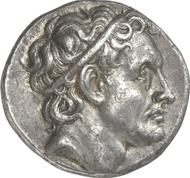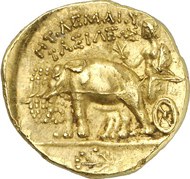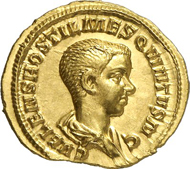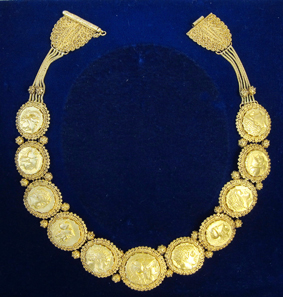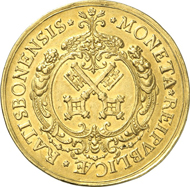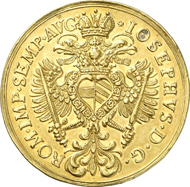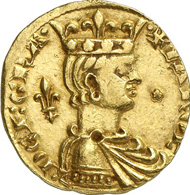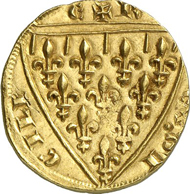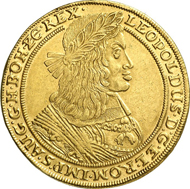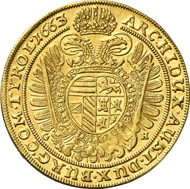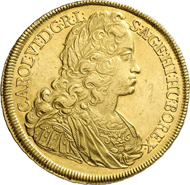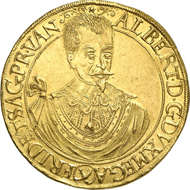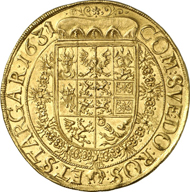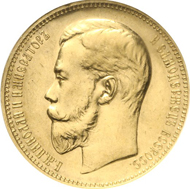06-10-2013 – 10-10-2013
Auction sales 236-239
High-denomination gold from the Holy Roman Empire
One attraction succeeds another – this is how the catalogs of the upcoming autumn sale of Künker’s, to be conducted between the 7th and the 11th October 2013 in Osnabrück, could be summarized. That holds true for high-denomination gold in particular, from the free imperial city of Regensburg and the Habsburg Empire: What is offered here breaks all records. It comes as no surprise then that the total estimate adds up to nearly 10 million euros. It should be stressed at this point that the other sections likewise come up with magnificent collections, for example tetradrachms from Hellenistic times and Roman gold coins for the section Antiquity.
Auction sale 236 – Ancient coins
On Monday, 7th October, the Künker auction week begins with the sale of the Dieter Grunow Collection. The widely known coin dealer, who has been a keen collector of ancient coins since his early adolescence, liquidates his collection of Hellenistic tetrachdrachms at Künker’s. With the expert’s eye he has assembled an exquisite series of Celtic and Greek coins that enchant thanks to outstanding condition, rarity and extraordinarily good style. The series comprise only 200 coins but every single one of these might well be the undisputed gem of a collection. Just think of the rare tetradrachm from Syros with the head of Demeter on the obverse and the two Cabeiri on the reverse (59, EF, estimate: 8,000 euros) …
73: Greek coins. Pergamon (Mysia). Philhetairos, 282-263. Tetradrachm, after 269. Houghton / Lorber 309. From auction sale Gießener Münzhandlung 199 (2011), 356. Very rare. Extremely fine. Estimate: 20,000 Euros.
… or probably the best portrait of Seleukos I on the tetradrachms of Philhetairos (73, EF, estimate: 20,000 euros). Whether Macedonia or Bactria – the connoisseur discovers rare, historically significant and beautiful pieces everywhere.
The general offer of ancient coins, however, is remarkable, too! 1,461 lots will be called out. Gold dominates the scene here! Be it a gold stater of Mithradates VI, the slayer of Romans (557, EF, estimate: 25,000 euros), …
678: Greek coins. Ptolemaios I, 323-305-283, King of Egypt. Stater, after 300, Euhesperides. Naville 239. From auction sale Auctiones AG 20 (1990), 519. Very rare. Extremely fine. Estimate: 25,000 Euros.
… of Ptolemaios I (678, EF, estimate: 25,000 euros) or a gold pentadrachm with the portrait of Berenice II (679, about EF / EF, estimate: 40,000 euros), the gold outshines the offer which is respectable not only in this regard.
It is the same with the Romans. They come up with such rare denarii, such interesting bronze coins, and yet it is the aurei that again catch the eye, whether the ones of Augustus, (891, VF+, estimate: 10.000 euros), Otho (980, VF, estimate: 25.000 euros), Domitian (1008, EF, estimate: 25.000 euros), Hadrian (1060, for Divus Traianus and Diva Plotina, about EF, estimate: 50,000 euros) …
1170: Roman coins. Hostilianus, 251. Aureus. RIC -. Calico 3316. Extremely rare, especially in this condition. Extremely fine to FDC. Estimate: 50,000 Euros.
… or of Hostilian (1170, EF-FDC, estimate: 50,000 euros). The range of offers presented here is remarkable.
466: Greek coins. Gold necklace with coins for Elisabeth, Queen of Greece, manufactured in the 1920s. From auction sale Platt, Paris, 26th November 1975, no. 135. Estimate: 25,000 Euros.
Of high historical interest – not just to the fan of ancient history – is a gold coin necklace manufactured in the 1920s for Elisabeth, wife of King George II of Greece. It consists of 5 gold staters of the Macedonian kings Philipp II and Alexander III, the central piece being a gold distater of Alexander. Because of the founding of the Republic of Greece, Elisabeth and her husband were driven into exile and the piece of jewelry couldn’t be presented to the queen anymore.
Auction sale 237 – Medieval and modern coins and medals
Auction sale 237 likewise commences with a collection: on offer is the Friedrich Popken Collection with coins from the cities of Barby, Corvey, Erfurt, Magdeburg, Mühlhausen, Nordhausen and Quedlinburg. Including everything from small to great rarities, everyone collecting one of these fields is required to browse the catalog carefully since this offer’s richness was never encountered on the market before.
Auction sale 238 – Bach Collection: coins of Regensburg
A zealous collector is Dr Karl Walter Bach, whose collection of coins from the city and the diocese of Regensburg makes auction sale 238. Whether a rare pfennig with a two-figure estimate or a 10 ducat piece with a five-figure estimate – the quality is always superb; the care and affection with which the collector made his choice are noticeable with every single item. Quite rightly, Andreas Kaiser refers to the collections as “probably the best collection of Regensburg coins in private possession – both in terms of quality and quantity”. Anyone interested in bidding for a specimen of this collection can do so with as low as 10 euros. Admittedly, it takes a bit more money to acquire the great rarities.
We would like to single out just the three most expensive lots here: 6 ducats 1667 with the title of Leopold I (4663, EF, estimate: 30,000 euros), …
4720: Germany. Regensburg. 10 ducats n. y. (1705) with title of Joseph I. Beckenbauer 203, X. From auction sale Hauck und Aufhäuser 16 (2001), 1672. Most likely the 2nd specimen in private possession. Extremely fine. Estimate: 40,000 Euros.
… 10 ducats no year (1705) with the title of Joseph I (4720, EF, estimate: 40,000 euros), and 8 ducats no year (1749) with the title of Francis I (4792, about EF, estimate: 30,000 euros).
Auction sale 239 – Gold coins, Germany after 1871, Russia
Anyone assuming that this was already the highlight is proven wrong since the gold coins in auction sale catalog 239 virtually take one’s breath away.
A clever strategy for special collectors might well be to lay aside money just now because nearly every country offers great rarities. Italy with its rare gold coins covering the High Middle Ages until the Empire is particularly well represented. Hence, not only one augustalis of Frederick II is on offer, but three at once (estimates ranging from 5,000 to 20,000 euros), in addition two 1/2 augustales (estimate: 20,000 and 10,000 euros, respectively) that are known to be even rarer than the full pieces.
5302: Italy. Sicily. Carlo I d’Angio, 1266-1282. Reale d’oro n. y., Messina. Fb. 75. Extremely rare. Extremely fine. Estimate: 25,000 Euros.
A reale d’oro of Charles of Anjou shouldn’t be omitted, who expelled the Staufer from Italy with papal support (5302, EF, estimate: 25,000 euros).
Truly unbelievable, then, is the content of the section Holy Roman Empire / House of Habsburg. The offer most likely will leave even the most experienced coin expert speechless. The dreikaiserthaler is rare and popular, but coming as a 5 ducat piece (5646, EF, estimate: 75,000 euros) and a 10 ducat piece (5645, EF, estimate: 80,000 euros), respectively, on just one auction sale – that is simply unbelievable. One second you are still amazed at a 10 ducat piece of Ferdinand III, minted in Prague 1640 (5653, EF, Estimate: 60,000 euros), the next second you realize that on the following page an even scarcer 10 ducat piece of the same ruler is offered for sale (5655, EF, estimate: 100,000 euros). The auction has climaxed with that, one is inclined to think. Wrong again, because Leopold I is the next in line – 10 ducats 1661, Prague (5662, EF, estimate: 100,000 euros), …
5663: Holy Roman Empire. Leopold I, 1657-1705. 10 ducats 1663 GH, Breslau. Fb. 258a. Unedited unique specimen. About extremely fine. Estimate: 125,000 Euros.
… 10 ducats 1663, Breslau, unedited unique specimen (5663, about EF, estimate: 125,000 euros) …
5673: Holy Roman Empire. Charles VI, 1711-1740. 10 ducats 1724, Vienna. Unique specimen. Extremely fine. Estimate: 150,000 Euros.
… and Charles VI – 10 ducats 1724, Vienna, unique specimen (5673, EF, estimate: 150,000 euros).
At this point, a special collection of gold coins of Emperor Francis Joseph might appear as something of a relaxation, although amongst the ‘ordinary’ gold coins rarities are included as well, such as the 100 kronen piece 1909 from Vienna with a mintage of just 3,203 specimens (5862, VF-EF, estimate: 1,500 euros). And of course rarities are to be encountered with the mediatized families, from the mint of the Count of Schlick, for example. To take just two cases in point: a unique 10 ducat piece from 1630 from the Horsky Collection (6140, EF, estimate: 125,000 euros) and from 1634 (6141, EF, estimate: 125,000 euros).
6143: Holy Roman Empire. Duchy of Friedland. Albrecht of Wallenstein, 1623-1634. 10 ducats 1631, Jitschin. Fb. 142. Very rare. Extremely fine to brilliant uncirculated. Estimate: 150,000 Euros.
Let us conclude the gold rush in the Habsburg Empire with a 10 ducat piece of Wallenstein as Duke of Friedland, minted in Jicin in 1631 (6143, EF-FDC, estimate: 150,000 euros).
Once again, the Künker autumn auction is terminated with Russian coins which include several candidates likely to yield record prices. Two important rarities at once are listed under Tsar Peter I: a ducat 1701, minted in Moscow’s Kadashevsky Mint (6872, VF, estimate: 50,000 euros) and an unsigned rouble-shaped silver medal from 1714, awarded as bravery medal for those soldiers who had fought in the naval Battle of Gangut on 27th July 1714 (6923, about EF, estimate: 30,000 euros).
Likewise remarkable is a poltina of Ivan III from 1741, that was auctioned off for the first time in 1932 in the sale ”Doubletten russischer Museen” at Hess in Frankfurt (6951, EF, estimate: 50,000 euros). A marvelous ensemble for coin aficionados is a set of gold, silver and bronze medal 1850 on the erection of the bridge of Blagoveshchensk crossing Neva River (7184, EF-FDC, estimate: 80,000 euros).
7315: Russia. Nicholas II, 1894-1917. 37 1/2 rouble (100 franks) 1920, St. Petersburg. In US-capsule of NGC with grading AU 50. Fb. 170. Mintage only 225 specimens. About extremely fine. Estimate: 75,000 Euros.
Let us conclude with a 37 1/2 rouble piece of Tsar Nicholas II from 1902, of which only 225 specimens were issued (7315, about EF, estimate: 75,000 euros).
The catalogs can be ordered at Künker, Gutenbergstrasse 23, D-49 076 Osnabrück; phone: 0541 / 96 20 20; fax: 0541 / 96 20 222; or via email. You can find all coins four weeks prior to the sale online.




